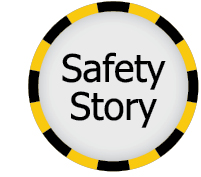 The U.S. Occupational Safety and Health Administration (OSHA) was created to ensure safe and healthful working conditions for workers by setting and enforcing standards. OSHA requires employers to keep a record of serious work-related injuries. This information helps employers, workers and OSHA evaluate the safety of a workplace, understand industry hazards, and implement worker protections to reduce and eliminate hazards. The following incident was reported to OSHA.
The U.S. Occupational Safety and Health Administration (OSHA) was created to ensure safe and healthful working conditions for workers by setting and enforcing standards. OSHA requires employers to keep a record of serious work-related injuries. This information helps employers, workers and OSHA evaluate the safety of a workplace, understand industry hazards, and implement worker protections to reduce and eliminate hazards. The following incident was reported to OSHA.
The incident
Missing pre-shift inspection has dire consequences
An employee was assisting a crane operator in the movement of a gang box using an overhead crane. The crane had two hoists—an 80-ton main hoist and a 10-ton auxiliary hoist— and was remote controlled.
The main hoist was being used to lower the gang box to a different level. The employee was assisting the operator in rigging the gang box and connecting it to the hook on the main hoist. The operator briefly operated the auxiliary hoist controller thinking he was actuating the main hoist controller on the remote control box. The operator then moved his hand over to the main hoist controller and raised the gang box several feet so it could pass over an adjacent guardrail.
Prior to the crane moving the gang box horizontally, a loud noise was heard from above. The auxiliary hoist load block assembly became separated from its wire rope load line and came crashing down striking the employee who was standing directly under it. The employee died from the injuries.
The auxiliary hoist load block weighed 231 pounds and free fell approximately 35 feet. The auxiliary hoist upper limit switch assembly did not function to prevent the two-block condition. Two-blocking occurred when the hoist block came into contact with a structural component of the crane's trolley assembly and ultimately caused the wire rope to break. The auxiliary hoist upper limit switch was not tested for proper operation prior to use.
Preventive measure
Daily or pre-shift inspection can alert you to safety risks
A daily inspection includes a check of limit switches by lifting and lowering the empty hook, driving the hoisting trolley toward the end of the bridge, and driving the crane towards each end of the runway. Running through these movements can alert you to issues before a load is even lifted.
Each of the items on the daily inspection checklist are integral to the safe use of a crane. In addition, a pre-shift functional inspection is a requirement in three separate regulations in the U.S. where this incident occurred.
Skipping daily or pre-shift inspections doesn’t save time because it takes just a few minutes to complete with Konecranes CheckApp for Daily Inspections and instructions are included in the app. And if you have an audit or an incident and need to show proof of daily inspections, CheckApp history can be shown quickly on the Konecranes Portal.
Not complying with the daily inspection requirement can bring fines, but more importantly it is a significant safety risk. Injury, loss of life, damage to product and equipment is way more costly than a fine for not complying.
Learn more about CheckApp for Daily Inspections
